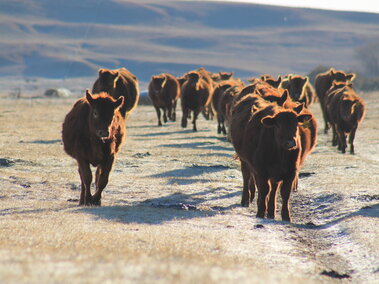Spring 2025 Ranch Update
Jacki Musgrave and John Nollette
We’ve had very little moisture this winter, and like much of the Sandhills, we’re eager for a break from the wind. We received about 5 inches of wet snow and some rain at the end of March. If we don't continue to get these much-needed spring rains, we could be heading into a drought situation this summer.
We have fertilized our home hay meadow for four years (2020-2023). In 2024, we carried over a good amount of hay from 2023. Based on this, the decision was made not to fertilize our meadows in 2024. Hay yield in 2024 was 92% of the average of the four fertilized years and 94.4% of our long-term average. Crude protein was slightly lower in 2024 (7.4 %), compared to our long-term average (7.8%).
Weaning weights from mature March-calving cows were lower in 2024 (511 lbs) than average (532 lbs). March cow body condition score (BCS) at weaning in 2024 was similar to our long-term average (5.3), while pregnancy rate was 2% higher than average (94.9% vs 92.9%). Weaning weights for March 2- and 3-year-olds were considerably lower than average (60 and 78 lb lower for 2- and 3-year-olds, respectively). Pregnancy rates were also lower for March 2- and 3-year-olds (73.1 and 69.7% (2024) vs 86.6 and 85.4% (average), 2- and 3-year-olds, respectively). March heifer pregnancy rates were 1.2% higher than average in 2024.
We feel lower pregnancy rates in the March-calving 2- and 3-year-olds were due to lower forage quality. Grass was plentiful due to timely June and July precipitation; however, quality was lower. Upland range diets from esophageally fistulated cows were 7.8% crude protein in June 2024 and 8.2% in July 2024, much lower than our long-term averages of 12.3% and 9.9% for these months.
The first week of December has been the weaning date for our mature May-calving cows since 2016. In 2024, Rick Funston started a weaning study with these cows comparing conventional December weaning with a date in late February. Weights from calves in December 2024 were lower (463) than average (476). Pregnancy rates were slightly higher (1.4%) while BCS was lower (0.2) than average.
Karla Wilke started a breeding season supplementation study with the May-calving 2- and 3-year-olds in 2024. Calf weaning weights for May 2-year-olds were 9 lb higher, while weaning weights for May 3-year-olds were 12 lb lower in 2024 than average. Pregnancy rate for May 3-year-olds was lower (90.5%) in 2024 than average (93.2%). However, pregnancy rates for May 2-year-olds were higher (96.4%) than average (86%). Pregnancy rates for both supplemented groups were higher than non-supplemented cows. May heifer pregnancy rates were higher (76.3) than average (68.5) in 2024.

March calving is going well, with 89.3% of the heifers and 83.8% of 3-year-olds calving in the first 21 days post due date. Mature March-calving cows had 83.6% calved at 21 days post due date.
Roger Carpenter, Ranch Technician at GSL since 2017, received the UNL IANR Outstanding Employee Award in December. The award recognizes employees who go above and beyond their job responsibilities. Roger is very deserving of this award. Congratulations Roger!